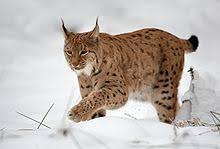The Eurasian lynx is the third grand predator of Europe, after the brown bear and the wolf. As good as extinct in central Europe: the solitary lively animal needs a territory of a few hundred to 1,000 km² of forest, and the very dense skin was three times more expensive than sable fur ... He was eagerly hunted. After reintroduction (Germany ..), lynxes are again observed after three centuries in 2004, among others in the High Fens (Belgium).
 The words lynx come from the Germanic luhs with an Indo-Germanic root 'leuk', which means 'lights' and points to sparkling eyes. Via the middle High German, in the Anglo-Saxon lox, it became 'los'. The Latin lynx also goes via the Greek lúnx (from the Proto-Indo-European * lewk), to 'light' in the eyes of the cat, and its ability to see in the dark.
The words lynx come from the Germanic luhs with an Indo-Germanic root 'leuk', which means 'lights' and points to sparkling eyes. Via the middle High German, in the Anglo-Saxon lox, it became 'los'. The Latin lynx also goes via the Greek lúnx (from the Proto-Indo-European * lewk), to 'light' in the eyes of the cat, and its ability to see in the dark.
There is a weak link with the legend of Lynceus and the Argonauts. He had special eyes and could see to the bottom of the sea and trough a wall of four feet ; and in the future.
The Eurasian lynx (Lynx lynx) is a feline predator of the size of a shepherd dog and related to the on the Iberian Peninsula living pardellynx (Lynx pardinus).
Lynxes are very weird and sheep-sled cats with characteristic ear plumes. They hunt their prey from an ambush, or as good climbers from a branch. They mainly hunt for hares (Lepus), roe deer (Capreolus capreolus) and chamois (Rupicapra rupicapra), rodents and poultry birds as partridges (Perdix perdix) and grouse (Lyrurus tetrix).
The lynx eats on average one kilogram per day. The prey remains are covered with vegetation an soil and are used up to 6 days.
In addition to the up to four centimeters long hair plumes that act as antennas on the ear tips, sideburns, long, heavy legs, and the mottled skin (especially on the legs) are typical. The tail is short (11 to 25 cm) with a black tip. Lynxes are resistant to cold, thanks to the dense rust-brown to yellow-brown coat and the hair cushions on their feet. The head-body length is between 80 and 130 cm in an adult lynx, the height at the withers is between 60 and 75 cm, 65 cm on average. Lynxes weigh 18 to 25, sometimes up to 38 kg.
Males have separate territories with overlays with those of also solitary living females. A cavern is usually used as a holle, but also a badger's burrow or dense thicket.
After the mating season from January to March comes a gestation period of about 74 days. Between one and five, usually two or three children are born in May of June. The eyes open after 16 to 17 days. The lactation takes two to four months. They leave the nest only after 4 months and stay with the mother for about 12 months. Females with young have a litter once every three years. The male helps the mother the first two months to take care of littles.
A male is sexually mature after about 30 months, a female after 22 months. A lynx becomes a maximum of 20 years old, an average of 15 years in the wild and 17 years in the imprisonment.
